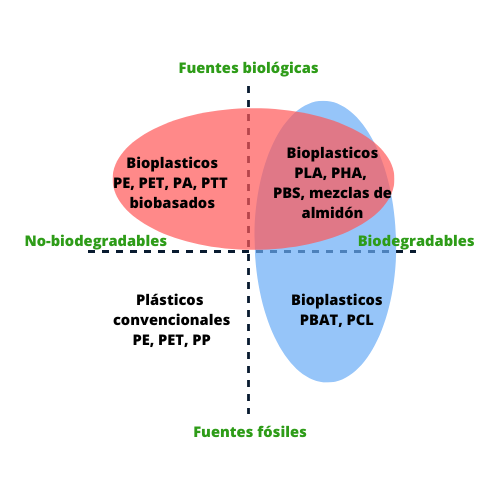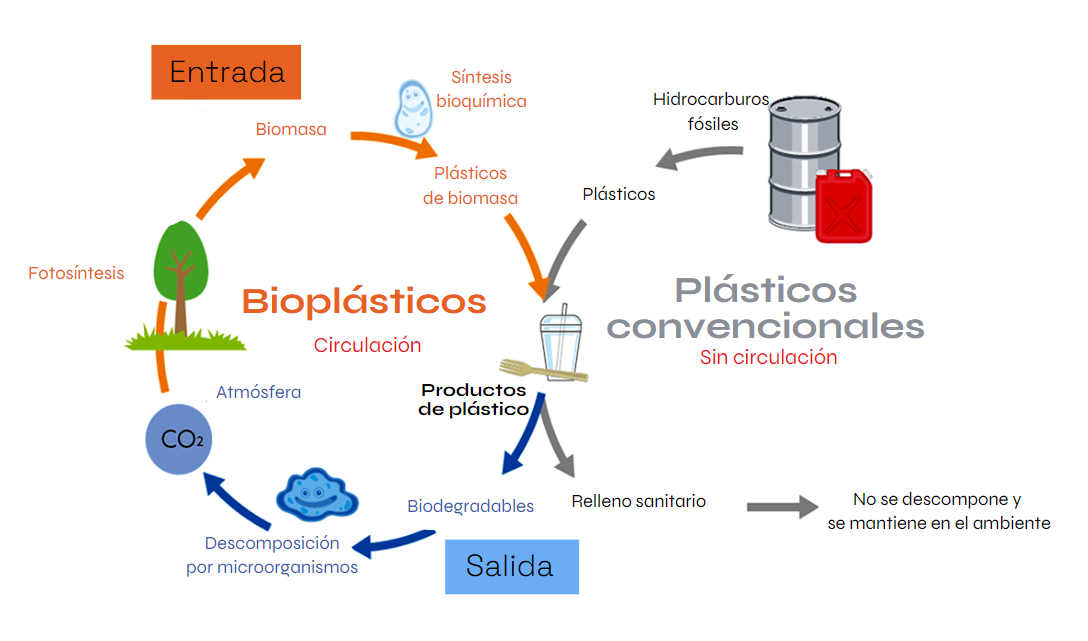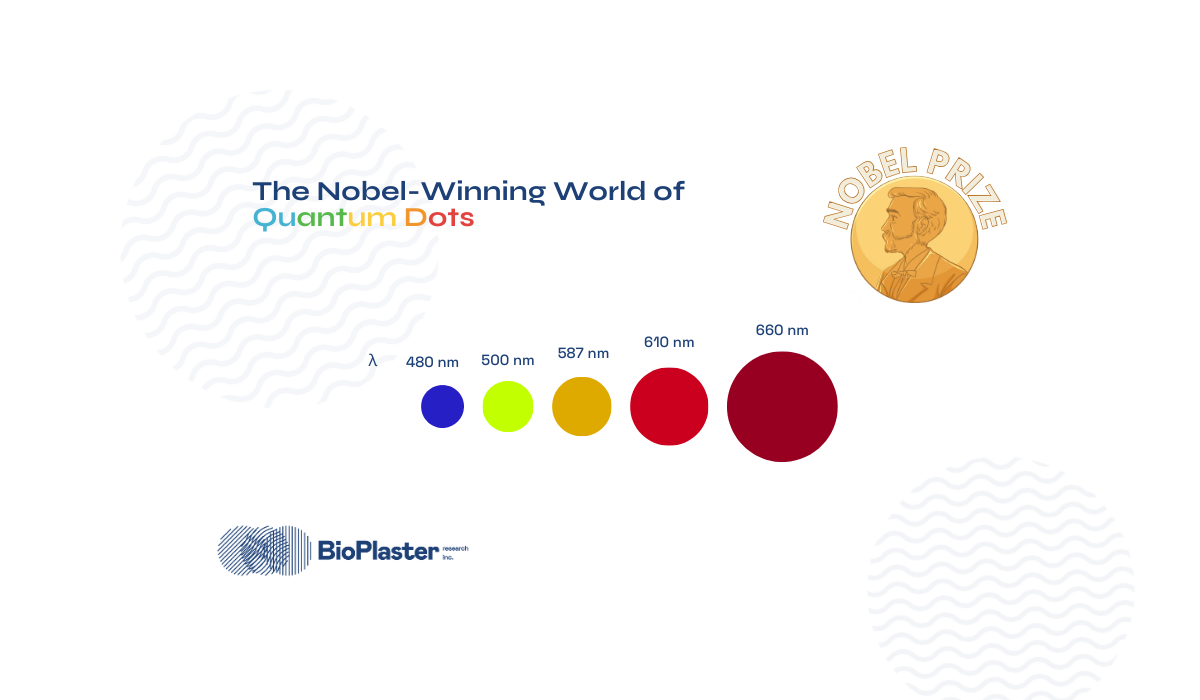At first glance, bioplastics sound like plastics made from biological sources rather than petroleum as a raw material. But bioplastics are more complex than that.
Plastics come in a wide variety of formats and shapes, from flexible, rigid, soft, transparent, etc. The word plastic itself, if you think carefully, can be confusing. In the general sense of the word, plastic is a descriptor of a material (or matter) that means that it can change shape. For example, in neurobiology, the term plasticity refers to the brain's ability to remodel itself in learning processes.
On the other hand, the word plastic is mostly used to refer to rigid materials that come from chemical work carried out on oil, as opposed to gasoline (fossil fuels). This second definition covers most of our experience with materials, from everyday objects such as glasses, cutlery and even the computer case where this post was written.
The plastic pollution crisis has been one of the main concerns in recent decades due to the double-edged consequences of plastics. Their mechanical properties are designed to perform in adverse weather conditions, they are light and resistant, they have versatile uses and, most attractively, they are very cheap. All these properties have made the production of plastics a very profitable business worldwide, with an expected production of these materials of 445 million tons per year by 2025.
But these same properties make plastics so durable and easily disposable that most of these tons are left in landfills, burned or lost in all ecosystems, reaching the bottom of the ocean.
Can we make “plastics” from sources other than oil, such as plants? Will this material be called plastic or bioplastic?
What if they have exactly the same properties as petroleum-derived plastics? Do the origin and destination of these materials matter?
Take a look at the following figure with four different categories of plastic materials.
But what's the difference between these categories? The origin of the material and the end of its useful life must be taken into account within a short period of time.

There are plastics made from petroleum that can degrade enough to be called biodegradable, and there are plastics of biological origin that cannot biodegrade at all.
The most environmentally friendly option seems to be a material from a sustainable source (to minimize oil extraction) and that can fully biodegrade (avoid long-term contamination). This makes us ask ourselves more questions. What is the best source to manufacture these materials and compete with traditional plastics? What are the most desirable characteristics for these plastics? Under what conditions should they be degraded?

One of the main challenges in manufacturing bioplastics is the availability and consistency of raw materials. Some raw materials, such as avocado seeds and other industrial waste, can be difficult to obtain in large quantities and their composition may not be homogeneous, which can make it difficult to manufacture bioplastics.
The most popular “biological and biodegradable” bioplastic is PLA (polylactic acid). This material has great physical properties, is consistent when melted and molded, can be given almost any shape and is very durable. The main source of this material is starch, which comes from potatoes or corn, and after use it can be degraded by composting to be used again as a natural fertilizer.
However, PLA fails on two main sustainability issues, raw materials and the easy return to ecosystems, why?

Starch comes from potatoes and corn, two very important food sources around the world, so using them to produce single-use cutlery puts food systems at risk. Does moving the problem to food systems solve our plastic needs? In addition, the corn used for PLA is manufactured without caring for the environment, it is grown using toxic chemicals because it is not for human consumption. Is that really sustainable?
A 2017 scientific study on the mitigation of greenhouse gases and plastics in the United States concluded that “due to heavy dependence on agriculture, biobased products tend to score poorly on environmental metrics, such as ozone depletion, acidification, eutrophication, water use, and food security” [2].
The second problem is that PLA products have to be collected after being dumped to achieve a process called industrial composting, which is different from domestic composting. PLA products have to be collected and taken to special landfills for the composting of organic waste. This is not the case, very few cities have the necessary infrastructure for composting [3], and many organizations that use compostable biopolymers continue to send their waste to landfills [4], maintaining the flow of waste in a way similar to a plastics economy based entirely on petroleum.
The constant development of technology in materials science is essential to continue moving towards sustainability, from new materials to their implications in the short and long term.
References:
- Shah, Manali & Rajhans, Sanjukta & Pandya, Himanshu & Mankad, Archana. (2021). Bioplastic for future: A review then and now. World Journal of Advanced Research and Reviews. 9. 056-067. 10.30574/wjarr.2021.9.2.0054.
- Posen, Daniel et al. (2017) Greenhouse gas mitigation for U.S. plastics production: energy first, feedstocks later. Environ. Res. Lett. 12 034024
- Hottle, T.A., Bilec, M.M., & Landis, A.E. (2013). Sustainability assessments of bio-based polymers. Polymer degradation and stability, 98 (9), 1898-1907
- Meeks, D., Hottle, T., Bilec, M. M., & Landis, A. E. (2015). Compostable biopolymer use in the real world: Stakeholder interviews to better understand the motivations and realities of use and disposal in the US. Resources, Conservation and Recycling, 105, 134-142.
Our Blog
At Bio+ we share relevant articles, research and news about innovation in bioplastics, sustainability and the environmental impact of materials. Find out how we're working for a more regenerative future.

